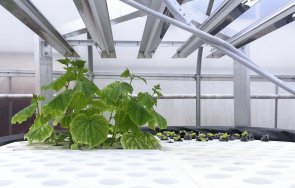
Getting Started with AquaGrove
New to aquaponics? No problem – AquaGrove has you covered. While taking the first steps into the world of aquaponics can be intimidating for those starting their gardens for the first time, aquaponics is truly a fun and engaging activity for students and a rewarding and healthy gardening method for growers of all ages. After all, it is the most natural and organic method for growing healthy plants and vegetables, and in order to take the mystery out of the process, AquaGrove offers a complete “Start-up Manual” with all of its Learn and Grow Systems. The starter guide provides an easy-to-follow walk through of steps, from cycling water through the system to adding plants and fish and eventually managing your garden and aquarium.
As listed in a video published by AquaGrove, the start-up process can be broken down into easy steps:
- Filter and Add Water to the Tanks – Beginning with the water, AquaGrove recommends testing your water source before use in any aquaponics system. Chlorine and Chloramine are very toxic to fish, and for this reason, it is imperative that such toxic substances are removed from the water prior to adding it to the system. It is estimated that 1 in 5 American households have water that has been treated with Chloramine, and more facilities are switching to this chemical on an annual basis. Once all of the Chlorine or Chloramine are removed, you will add water to the tanks, adjust the pH level and obtain the optimum temperature for the species of fish you have selected to raise. You will also want to pay attention to the Dissolved Oxygen (DO) level which can be easily managed with the air stones that are included with the AquaGrove Learn and Grow System.
- Begin “Cycling” – Cycling refers to the process of establishing a beneficial nitrifying bacteria colony which will convert fish waste into plant fertilizer. This process is called the Nitrogen cycle. You should test your water daily with the test kit provided in AquaGrove’s starter kit. It is also helpful to maintain records when you test your water as they will enable you to gain a better understanding of your water quality, and aid in preventing potential issues. You may refer to AquaGrove’s Start-up Manual to understand the test values and levels that will keep your water in the “safe range”.
- Introduce Fish to the Lower Tank – This step proves to be the most exciting, especially for younger growers. Tilapia is the fish of choice for beginners just learning how to use their aquaponic system; they are the easiest to raise and can handle the fluctuations that will most likely occur when getting started. Whether you choose tilapia or a more demanding fish species, be sure to research your selection carefully and understand its needs.
- Add Seeds to the Grow Raft – Seeds can be started at the beginning of cycling, with or without fish. Seeds contain everything needed to germinate and grow until Nitrates are present during cycling. The AquaGrove Learn and Grow includes a wide spectrum lighting system that can be used with a variety of plants and will provide your plants with essential light no matter your location or climate.
- Perform Regular Maintenance – Regular maintenance includes feeding fish, checking/adjusting pH, cleaning filters, as well as checking the water levels to ensure that you refill and top off to compensate for evaporation.
The early stage of the start-up process is the most demanding part of aquaponics. The truth is that once your system is cycling and balanced, the maintenance and demand decreases significantly, as fish and plants thrive and mutually provide everything they need to grow. Although the steps have been summarized above, a full and detailed explanation of each step and list of supplies is included with every AquaGrove system, along with a supportive technical and customer service team. To learn more about getting started with AquaGrove, contact a team member today.
